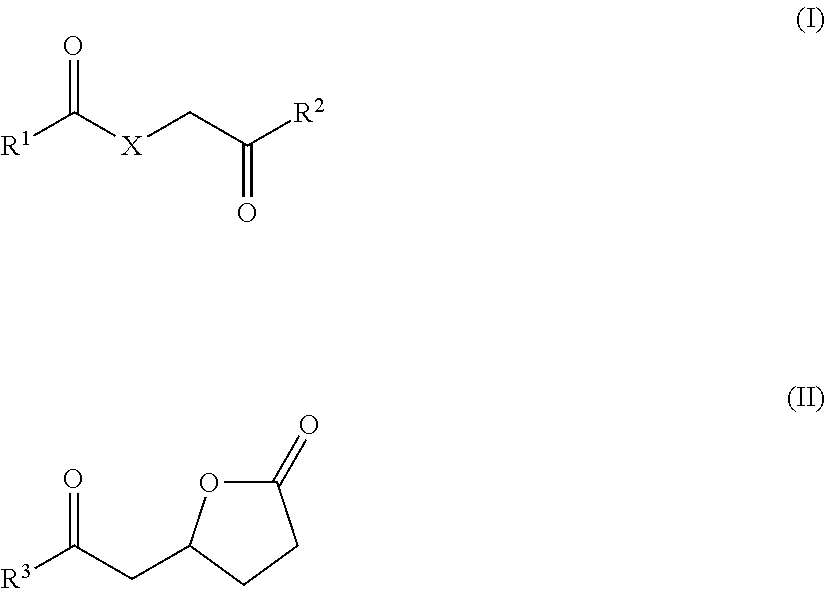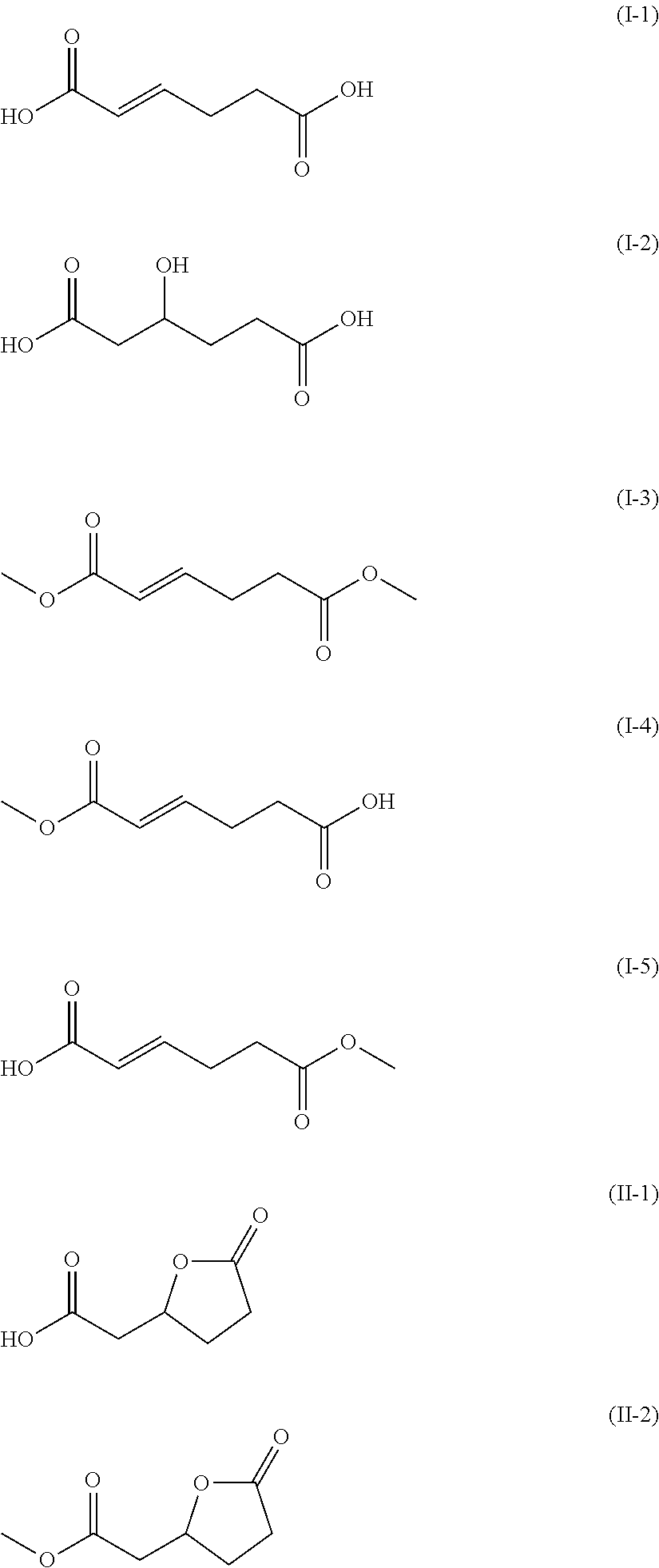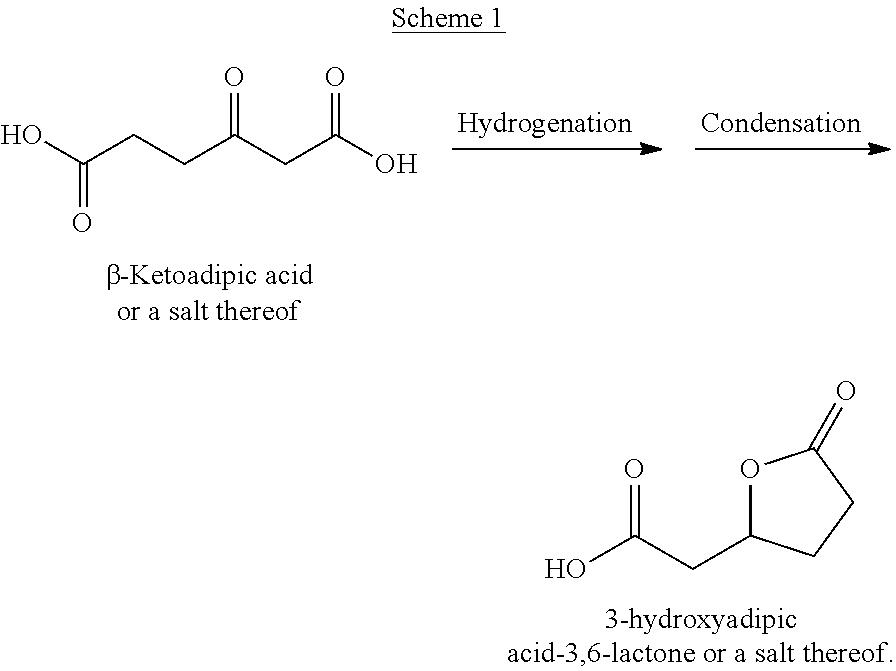Method for producing epsilon-caprolactam
a technology of epsilon caprolactam and caprolactam, which is applied in the direction of physical/chemical process catalysts, bulk chemical production, metal/metal-oxide/metal-hydroxide catalysts, etc., can solve the problem of large amount of ammonium sulfate produced, and achieve the effect of suppressing the production of by-products
- Summary
- Abstract
- Description
- Claims
- Application Information
AI Technical Summary
Benefits of technology
Problems solved by technology
Method used
Image
Examples
reference example 1
Preparation of α-Hydromuconic Acid (I-1)
[0048]The α-hydromuconic acid used in the present invention was prepared by chemical synthesis.
[0049]First, 1.5 L of super-dehydrated tetrahydrofuran (manufactured by Wako Pure Chemical Industries, Ltd.) was added to 13.2 g (0.1 mol) of succinic acid monomethyl ester (manufactured by Wako Pure Chemical Industries, Ltd.), and 16.2 g (0.1 mol) of carbonyldiimidazole (manufactured by Wako Pure Chemical Industries, Ltd.) was added thereto with stirring, followed by stirring the resulting mixture under nitrogen atmosphere for 1 hour at room temperature. To this suspension, 15.6 g (0.1 mol) of malonic acid monomethyl ester potassium salt and 9.5 g (0.1 mol) of magnesium chloride were added. The resulting mixture was stirred under nitrogen atmosphere for 1 hour at room temperature, and then stirred at 40° C. for 12 hours. After the reaction, 0.05 L of 1 mol / L hydrochloric acid was added to the mixture, and extraction with ethyl acetate was carried ou...
reference example 2
Preparation of 3-Hydroxyadipic (I-2) Acid
[0052]The 3-hydroxyadipic acid used in the present invention was prepared by chemical synthesis.
[0053]First, 1.5 L of super-dehydrated tetrahydrofuran (manufactured by Wako Pure Chemical Industries, Ltd.) was added to 13.2 g (0.1 mol) of succinic acid monomethyl ester (manufactured by Wako Pure Chemical Industries, Ltd.), and 16.2 g (0.1 mol) of carbonyldiimidazole (manufactured by Wako Pure Chemical Industries, Ltd.) was added thereto with stirring, followed by stirring the resulting mixture under nitrogen atmosphere for 1 hour at room temperature. To this suspension, 15.6 g (0.1 mol) of malonic acid monomethyl ester potassium salt and 9.5 g (0.1 mol) of magnesium chloride were added. The resulting mixture was stirred under nitrogen atmosphere for 1 hour at room temperature, and then stirred at 40° C. for 12 hours. After the reaction, 0.05 L of 1 mol / L hydrochloric acid was added to the mixture, and extraction with ethyl acetate was carried ...
reference example 3
Preparation of 3-Hydroxyadipic Acid-3,6-Lactone (II-1)
[0056]The 3-hydroxyadipic acid-3,6-lactone used in the present invention was prepared by chemical synthesis.
[0057]First, 1.5 L of super-dehydrated tetrahydrofuran (manufactured by Wako Pure Chemical Industries, Ltd.) was added to 13.2 g (0.1 mol) of succinic acid monomethyl ester (manufactured by Wako Pure Chemical Industries, Ltd.), and 16.2 g (0.1 mol) of carbonyldiimidazole (manufactured by Wako Pure Chemical Industries, Ltd.) was added thereto with stirring, followed by stirring the resulting mixture under nitrogen atmosphere for 1 hour at room temperature. To this suspension, 15.6 g (0.1 mol) of malonic acid monomethyl ester potassium salt and 9.5 g (0.1 mol) of magnesium chloride were added. The resulting mixture was stirred under nitrogen atmosphere for 1 hour at room temperature, and then stirred at 40° C. for 12 hours. After the reaction, 0.05 L of 1 mol / L hydrochloric acid was added to the mixture, and extraction with e...
PUM
| Property | Measurement | Unit |
|---|---|---|
| pressure | aaaaa | aaaaa |
| pressure | aaaaa | aaaaa |
| temperature | aaaaa | aaaaa |
Abstract
Description
Claims
Application Information
 Login to View More
Login to View More - R&D
- Intellectual Property
- Life Sciences
- Materials
- Tech Scout
- Unparalleled Data Quality
- Higher Quality Content
- 60% Fewer Hallucinations
Browse by: Latest US Patents, China's latest patents, Technical Efficacy Thesaurus, Application Domain, Technology Topic, Popular Technical Reports.
© 2025 PatSnap. All rights reserved.Legal|Privacy policy|Modern Slavery Act Transparency Statement|Sitemap|About US| Contact US: help@patsnap.com



